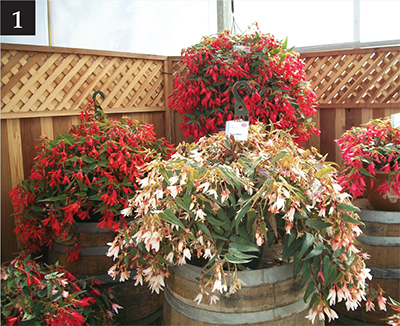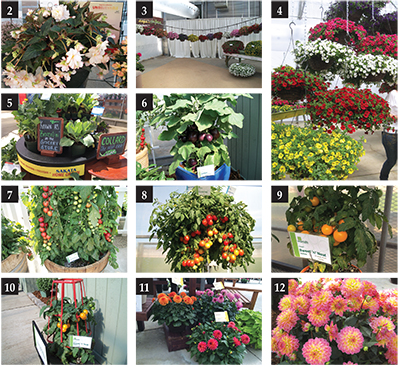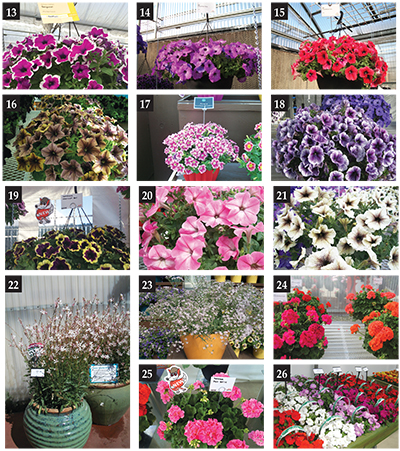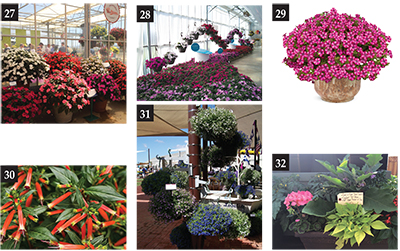
Features
Crops
New Varieties
Growing in the Green: Some California standouts
June 11, 2014 By Melhem Sawaya
The California Spring Trials, in reality, is a showcase by breeders – that is why I like calling it The California Showcase.
The California Spring Trials, in reality, is a showcase by breeders – that is why I like calling it The California Showcase.
In my view, it is running out of ideas to keep attracting the same visitors each year. If you are visiting the trials for the first year, or for the last two years, yes, you will still learn something new. Or you can skip two or three years and make the trip truly worthwhile.
In my experience, less than 15 per cent or so of event attendees are growers. The Showcase is geared to buyers, and more specifically, to brokers or chain buyers. Perhaps that is why the trial aspect disappeared many years ago.
And taking a whole week to visit the trials, at a cost of about $3,000 to $4,000 per person, makes it difficult for most growers to visit the show.
Often a chain wants exclusivity with a new cultivar. In my experience, that process is the number one factor of shrinkage in profit for the grower and the chain. It is also the best recipe for eliminating more retail customers because:
- It didn’t go through a garden performance trial.
- No customer appeal study has been done.
- The know-how to produce a top-quality product for a specific date has not been established in a commercial greenhouse setting.
Increasing the consumption of horticultural products can only be done by ensuring consumers are successful and satisfied with their purchases. We must never set them up to fail.
This is the reason I share these varieties with you. They are meant to be trialled at your own facility so you know how to grow them. Track their consumer appeal and monitor their garden performance.
In this issue we offer only a sampling of the hundreds of varieties that are shown in California.
Many of the varieties are new introductions for 2014, while others are older varieties that have been improved or changed but that carry the same name. And there are others that have been around for many years, but new trends now make them important varieties to share with you.
Remember to trial any variety new to your operation on a small scale to evaluate it thoroughly. Talk to salespeople and consultants, read the trade magazines, and visit trade shows to do your homework before deciding whether to continue growing this variety.
SAMPLING THE TRIALS

|
|
Bossa Nova (1) is one of the many Boliviensis begonia series introduced over the past few years. Boliviensis begonia grow well in the shade but are much better in semi shade or full sunlight as long as they are well hydrated. Bossa Nova is a trailing series that is great in large, hanging baskets.
‘Miss Montreal’ (2) is another begonia. It is part of a collection that has a mounding habit. It will flourish in shade, to semi shade, to full sun as long as it is well hydrated.
Cabaret (3) is a uniformly flowering calibrachoa series with a medium growing habit. It will flower well in a 12-hour photoperiod but will do much better when the days are longer with very sunny skies. Calibrachoa as a genus is taking the lead in sales compared to any other bedding plant variety. Use them in any size pot. They are excellent in almost any combination!
Kabloom (4) is the first seed calibrachoa that will fit into most operations. I have a good first impression of this seven-colour series. However, I need to see its performance in our field trials this summer and on a larger scale in the greenhouse production before I make a proper assessment. You can use Kabloom any place that you might use vegetative calibrachoa.
Broccolini and collard (5) vegetables are on the increase in recent years. They are being promoted because of their nutritional benefits and ease of growing.
Eggplant ‘Jackpot’ (6) in a container is one of the few vegetables that can be grown successfully in containers. Put only one plant in an oversized container (size 14” and up) in full sun and water when dry and you can pick your eggplant fresh from the patio.

|
‘Pink Charmer’ (7) is a vigorous growing tomato, so it should be grown either in ground beds or super large containers (such as a half barrel). It is very rewarding to have clusters of tomatoes picked from your own plants.
‘Sunset Falls’ (8) is a mounding to trailing tomato with loads of small tomatoes. Plant only one plant in a very large basket 12” and larger. Don’t be tempted to put in more than one plant because their competition will delay the picking date. It will be much harder to keep alive.
Sweet ’n’ Tomato (9) and (10) is a very compact variety with a 50-day tomato from seeding. It is fast and easy to grow, and its fruit can be quite tasty. It is mainly used for density growing and for fast production in a medium-size container.
‘Grandahlia’ (11) is a new series, and why not! Every breeder has to have a fast-growing market for lovely dahlia blooms. We will have this series in our trials to compare with all the other dahlia cultivars.
‘Hypnotica Rose Bicolour’ (12) will be popular. In the crowded dahlia market, a bicolour variety will stand out in a class of its own. Hypnoticas do very well in mixed containers and much better in landscapes where the rhizomes are not over-heated which is a detrimental factor in the successful growing of dahlia.
What’s new with petunias? Sanguna Picotee Punch (13), Glow Flour Rose (14), Glow Forest Fire (15), Happy Magic Dark Caramel Star (16), Marvel Beauty Cranberry (17), Purple Vein Ray (18), Sweetunia Moonlight Bay (19), Viva Glow Select Pink Stardust (20) and Viva Glow Cappuccino (21) are only nine of more than 30 new cultivars that make a marvellous rainbow of colours.
The only problem with rainbows is that they do not last long. Most of the new petunia breeding is targeting the most exquisite flowers; there is not much attention to the plant structure or growth habit. Often, they do not get into garden trials until after they are introduced and sold to consumers, with companies counting on the impulse of the consumer to buy them.
We do not give much thought to how well the plant will survive in the garden. It’s as if we are breeding cut flowers, with the expectation the plants won’t last more than two or three weeks. Every consumer that is set up to fail in growing plants is lost as a customer for life.
The breeding of nice-looking flowers is great as long as the plants are proven to grow well in a garden under normal conditions and not just in a research facility.

|
By no means am I implying you should not try the new varieties. On the contrary, try them in the greenhouse and also plant them in your garden. Provide feedback to the breeders and brokers.
Gaura ‘Sparkle White’ (22) is a variety from seed that has a balance of vigour and flowering. Its good branching habit makes it an excellent thriller in any combination or mass landscape. Grow in 4” or 6” pots, or use three to four plugs in large containers. ‘Sparkle White’ will add a lot to any mixed container without overpowering the other cultivars.
Gypsophila Festival (23) is a tender perennial that flowers in the spring under long days and all the summer until frost. It is excellent in hanging baskets, 4” pots for landscapes, or in combinations in place of bacopa. Try Festival on a small scale until you are comfortable with the timing of its flowering and its growing requirements.
The Master Idol series (24) features large geraniums with excellent greenhouse and garden habits. Only large, vigorous geraniums are to be grown in combinations if we want the geranium to show well at retail. Master Idols are great for this purpose, as well as for 6” or larger containers.
‘Pink Batik’ (25) is one colour in the Survivor series. This is a vigorous series that has excellent greenhouse and garden performance. It is ideal for use in landscape, large pots and hanging baskets, as well as combinations if you insist on having geraniums in combinations.
Divine Impatiens (26) is the New Guinea impatiens from seed that many growers are using to replace Impatiens wallerina. Divine Impatiens grows well in the sun as long it is well watered.
Sunpatiens (27) is my favourite impatiens because of its garden performance in the sun or shade. It definitely rivals the walleriana impatiens in its growth habit. One Sunpatiens plant will cover the same area as 12 walleriana impatiens! It can be grown in 6” or larger pots, especially if the vigorous varieties are chosen that work well in large containers and are excellent in garden performance.
Impatiens Bounce (28) is a new alternative to the walleriana impatiens. It is supposed to grow well in the sun and in the shade, similar to the Sunpatiens. We will have all these impatiens varieties in the sun and in the shade to see their garden performance, and we are planting them in beds that last year had downy mildew to determine their resistance to downy mildew.

|
Vermillionaire (29), like all cupheas, likes the heat and will thrive very well in any landscape but definitely will flower much more in full sun. For long-lasting cuphea, keep the plants moist especially until the plants get established. As an added bonus, hummingbirds are big fans and will choose them over almost any other plant in the landscape.
Supertunia Charm petunia (30) fits into many applications in the garden, including landscapes, combinations or large containers. It has a medium-size flower that is self-cleaning and has the extra energy to be mounded with lots of flowers.
Tide Pool (31) is a new series of lobelia. Most of the new breeding of lobelia is focused on more heat tolerance and longer-lasting flowers in the summer. We will have it in our trials and I am anxious to see how it compares to other lobelias. Lobelias are excellent in combinations because they synergize with other cultivars (rather than dominate or be dominated). That is why trailing lobelia varieties are much better in combination than the upright ones.
I am mentioning this window box mix combination (32) to demonstrate that there are no limitations with combinations. A mix of flowers with vegetables is great! Other mixes could feature annuals with perennials, or annuals with flowering shrubs or evergreens or tropical plants. The only common denominator is to have plants that will coexist and synergize their appearance in the combinations, and that will thrive the whole summer long.
There have been rumours that breeders are working to have the California Spring Trials held in one large location to attract more visitors and save themselves thousands of dollars. As I said, this is most probably just a rumour because it would require co-operation and a change from the way we’ve been doing it all these years. Heaven forbid we change things!
I’ve been mentioning this repeatedly over the past few years. In a way, the process is already underway, but for different reasons. Companies have been bought or are amalgamating, and this means fewer players. Geographically, the locations are now closer together, meaning that much less driving is required.
It has been said many times that if we are not a part of the solution, we are part of the problem. Poorly performing varieties frustrate gardeners to the point they might never buy plants again.
And here’s a reminder that all these varieties, along with 2,200 others, will be in the Sawaya Garden Trials this summer. The open house is July 23. Everyone is welcome and no registration is needed. Please enjoy the trials and fellowship, and a lunch will be provided.
Melhem Sawaya of Focus Greenhouse Management is a consultant and research coordinator to the horticultural industry. Comments on this or any other article are welcome at mel@focusgreenhousemanagement.com.
Print this page